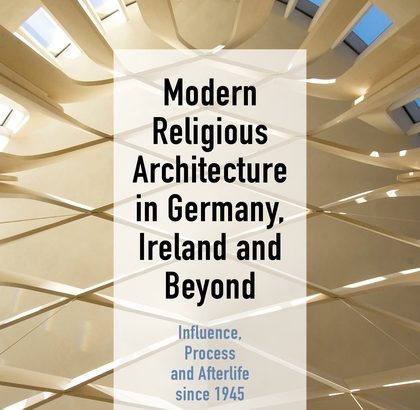Modern Religious Architecture in Germany, Ireland and Beyond: Influence, Process and Afterlife since 1945
Lisa Godson & Kathleen James-Chakraborty
(Bloomsbury Visual Arts, £44.95/$US80.00)
This collection of 11 articles derives from a conference held in Newman House in Dublin back in 2014. Alas, for the general reader concerned with religious architecture it is written in the staid and dense prose of the modern academic style, which all too often erects a barrier between researchers and the largest possible audience for the new knowledge they are generating.
The authors are concerned with three large topics: the emergence of religious building in the modern styles, both in Germany and Ireland, religious architecture in the two countries in the last century, the religious spaces of minority faiths specifically Muslim and Jewish – which in both countries have had troubled pasts, and the now pressing matter for both architects and communities of what can be done to preserve and recycle religious buildings for which there seems to be no continuing ritual use.
Exciting things
On all these topics the papers have interesting and exciting things to say. Six of the papers deal with Irish matters. There is a discussion of the work of Liam McCormack and Imogen Stuart which touches on many vital factors in the emergence of modernism in the Irish Church.
There is an important treatment of Andrew Devane’s Dublin churches in what is called here “the age of tentative radicalisation”, the period 1960-75.
But equally important is the papers by Melanie Brown on the ritual spaces of the Dublin Hebrew Community, past and present. It would have been good to have a discussion of Dublin Muslim architecture – seeing as how the enthusiasm for our mosques of the new director of the Goethe Institute when she first came to Dublin gave rise to this whole project.
The discussion by Jill Kerry on the new life that may be given to churches in Ireland (based on experience in Ulster) needs reading and discussion.
This reviewer takes the view that having been paid for by the public in the past and having been intended for public use, they should remain for community use and not be privatised. But the temptation to sell them off is a strong temptation to those who own them – which is not, of course, the parishioners.
But the most exciting paper is one which opens up new perspective not only on the Irish missionary movement, but also of the thrust of Irish art and architecture in contexts far away from this island, is the paper by the editor Lisa Godson entitled ‘Ireland’s tropical Modernists: Pearse McKenna and the Kilteegan Fathers in Nigeria, 1947 to 66’.
The young architect was given a brief instruction when he was engaged by the order: “Just build something modern.”
The results were remarkable, considering that at this date Archbishop McQuaid was still insisting upon the erection of historicist Roman basilicas in the suburbs of Dublin.
If one were to read only one of these paper it would have to be Lisa Godson’s, a really exciting piece of research which alters views, and extends ideas about Ireland in the world today.


 Peter Costello
Peter Costello